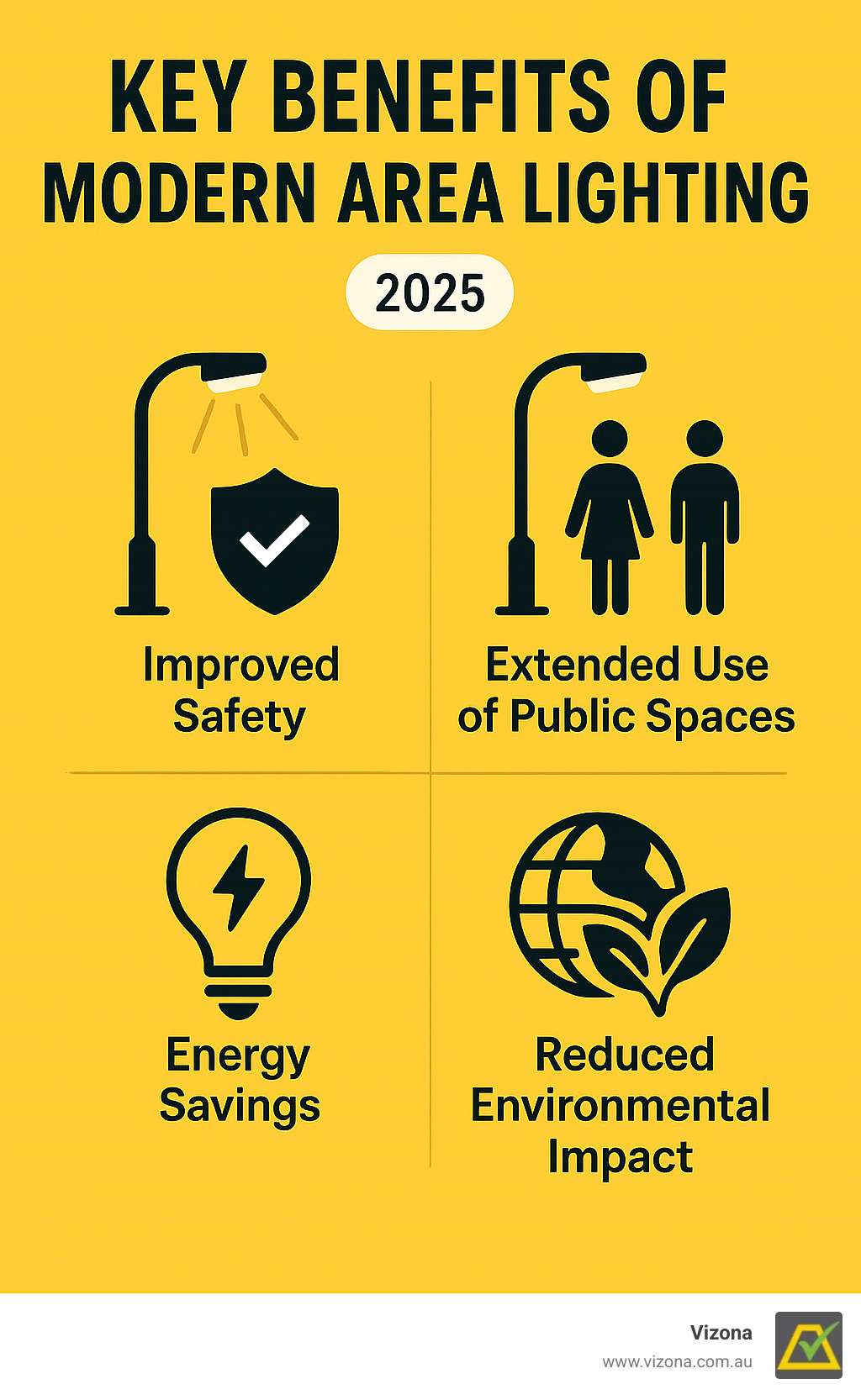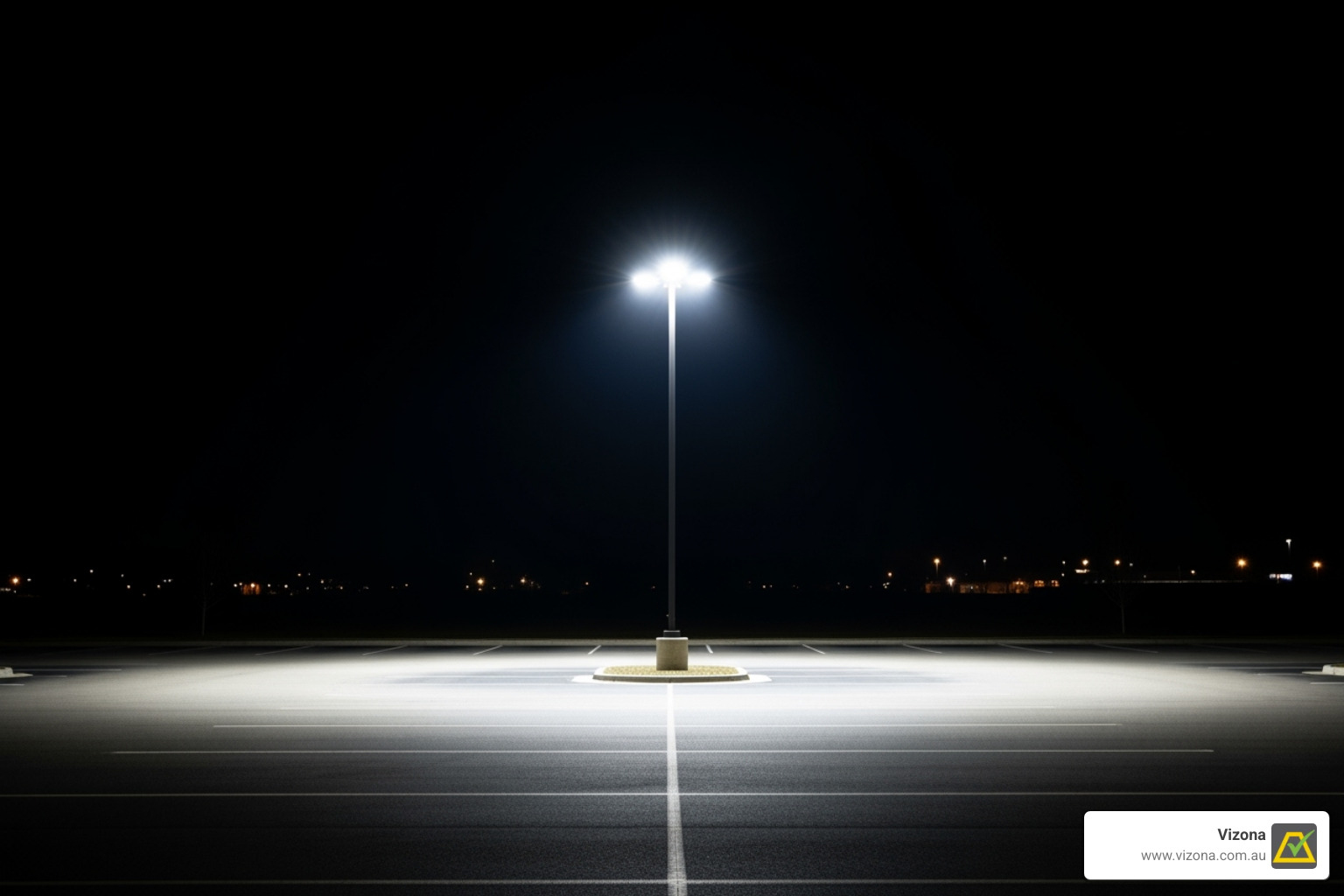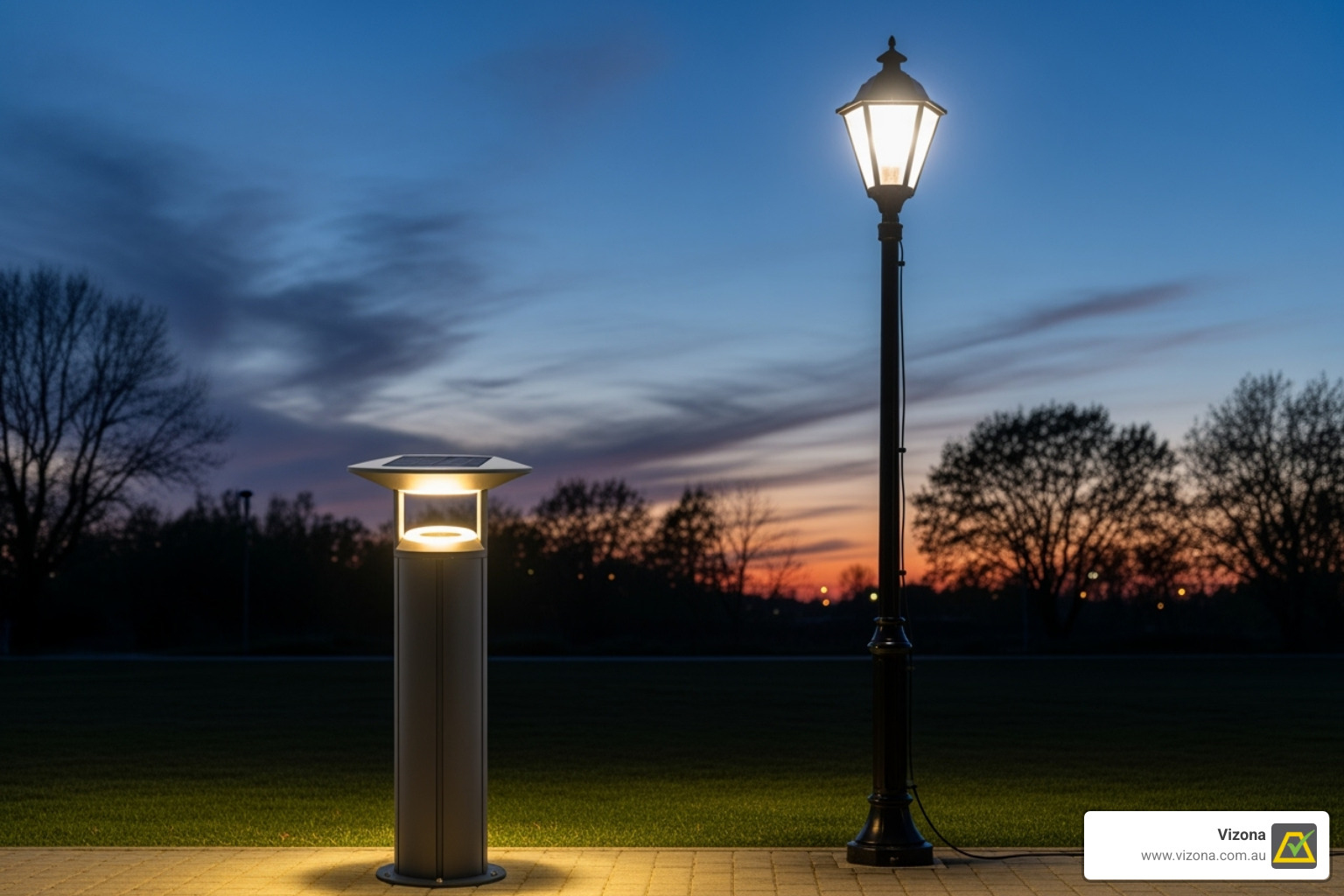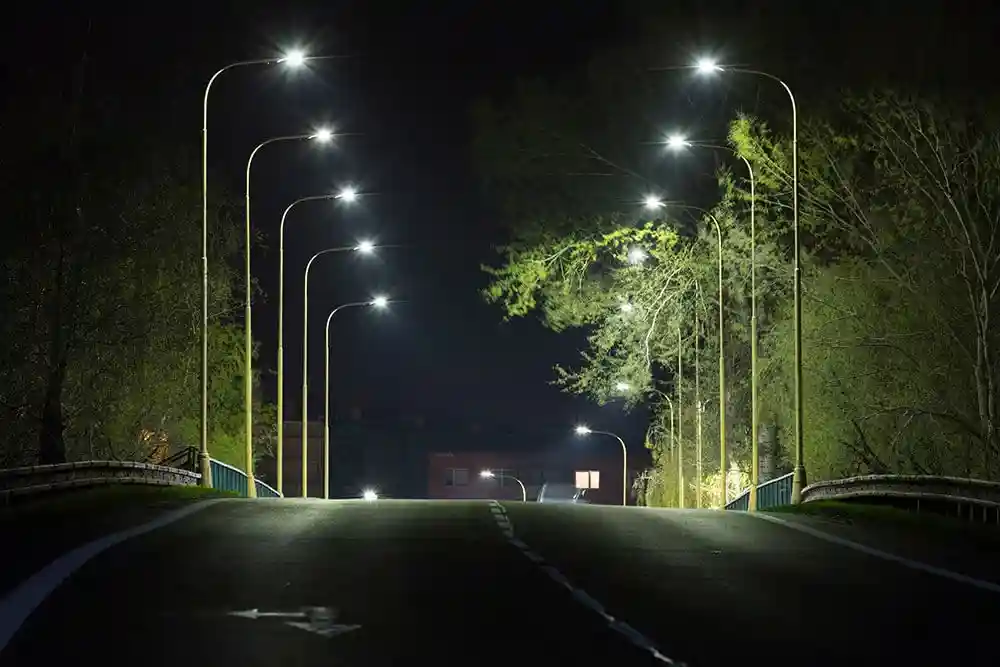Why Area Lighting Solutions Matter for Modern Communities
Area lighting solutions are comprehensive outdoor lighting systems designed to illuminate large spaces safely, efficiently, and sustainably. These systems range from solar-powered bollard lights for pathways to high-output LED luminaires for sports fields and commercial areas.
Quick Overview of Area Lighting Solutions:
- Street and roadway lighting: Hardwired LED systems for continuous illumination.
- Sports field lighting: High-performance luminaires meeting AS 2560 standards.
- Car park and commercial lighting: Energy-efficient solutions for safety and security.
- Pathway and bollard lighting: Solar-powered options for pedestrian areas.
- Mobile lighting towers: Portable solutions for temporary or remote sites.
The demand for effective area lighting is growing as councils across Australia upgrade aging infrastructure to meet sustainability targets and sporting clubs seek modern LED systems to extend facility usage hours. While approximately 25% of light sources nationwide currently use LED technology, this figure is rapidly increasing as organisations recognise the significant energy savings and reduced maintenance costs.
Modern area lighting solutions deliver benefits beyond basic illumination, including:
- Improved Public Safety: Uniform light distribution improves safety for pedestrians and vehicles.
- Extended Facility Use: Operational hours of recreational facilities can be extended into the evening.
- Environmental Advantages: Reduced energy consumption and the use of recyclable materials like aluminium offer substantial environmental benefits.
The shift to LED systems is a strategic investment in infrastructure that delivers measurable returns through lower electricity bills, reduced maintenance, and improved compliance with Australian Standards for outdoor lighting.
With over 20 years of experience delivering area lighting solutions for major infrastructure projects, including Snowy Hydro 2.0 and community facilities across Australia, Vizona possesses unique insight into what works in Australian conditions. Our expertise spans everything from remote off-grid installations to Tier 1 infrastructure projects.
Guide Overview
This guide provides a comprehensive overview of area lighting solutions, from foundational concepts to advanced planning. It details the types of systems available, essential technical specifications, and the process for designing a compliant and effective lighting plan for any outdoor environment.

Understanding the Fundamentals of Area Lighting

What is an Area Light and What is its Primary Purpose?
An area light is an outdoor luminaire engineered to provide broad, uniform illumination across large open spaces. Unlike spotlights that focus a narrow beam, area lights distribute light widely to ensure consistent coverage. This approach is critical for minimising dark spots and harsh shadows that can create safety hazards.
The primary objectives of area lighting solutions are:
- Safety: Illuminating pathways, intersections, and potential hazards to facilitate safe movement for pedestrians and vehicles.
- Security: Deterring unauthorised activity and supporting surveillance by eliminating opportunities for crime.
- Functionality: Extending the operational hours of parks, car parks, industrial yards, and sports facilities beyond daylight.
- Aesthetics: Improving the visual appeal of landscapes and built environments to create more inviting atmospheres.
A professional approach focuses on creating consistent illumination that prevents light trespass and avoids "hot spots" of excessive brightness that cause glare and visual discomfort.
Common Applications for Area Lighting
Area lighting solutions are custom to diverse environments, each with unique requirements.
Public and Civic Spaces
- Car parks and transport hubs: Require lighting that ensures safe navigation and security.
- Public parks, pathways, and cycleways: Benefit from illumination that extends usability and promotes safety.
- Community recreational areas and playgrounds: Need adequate lighting for evening activities to foster community engagement.
Sports and Recreational Facilities
- Community sports fields (AFL, soccer, rugby): Must meet specific Australian Standards for sports lighting to ensure optimal player visibility.
- Tennis and netball courts: Require uniform, high-quality illumination for competitive play and spectator enjoyment.
- Learn about Vizona's LED sports lighting systems designed for performance and efficiency.
Commercial and Industrial Environments
- Industrial yards and outdoor storage areas: Need robust lighting to improve safety, security, and productivity.
- Resource processing facilities: Require reliable illumination for demanding, continuously operating environments.
- Building perimeters and loading docks: Must be lit to ensure secure and efficient logistics.
Temporary and Remote Locations
- Construction and infrastructure sites: Need portable lighting for evolving work zones.
- Emergency response and event management: Demand rapidly deployable lighting for critical situations.
- Mine sites: Require durable illumination capable of withstanding challenging conditions.
- For versatile temporary lighting, explore Vizona's mobile solar lighting towers.
Selecting the Right Area Lighting Solutions for Your Project

Types of Area Lights by Power Source
Choosing the right power source impacts installation complexity, operational costs, and environmental footprint.
Hardwired (Mains Power) systems connect to the electrical grid for consistent, high-output illumination. They are ideal for permanent installations like street lighting and large commercial car parks where reliable power is available and smart control systems may be required.
Solar Powered solutions use photovoltaic panels to charge integrated batteries, powering LED luminaires overnight. They are perfect for off-grid locations, parks, and pathways, as they eliminate the need for costly trenching and cabling, reduce carbon emissions, and operate with no electricity costs. Our systems are engineered for reliability in all Australian weather conditions.
- For pathways, consider the BASSO Solar Bollard Light or the Nomad 3 Solar Bollard Light.
Mobile Lighting Towers are portable, self-contained units for temporary or evolving applications like construction sites, events, and mining operations.
- Our solar models, like the Commander 4 Panel and Commander 3 Panel, offer zero running costs and emissions.
- For applications requiring extended runtime, the Bravo Swift Diesel-Powered Lighting Tower delivers powerful, continuous light.
Determining the Appropriate Brightness (Lumens)
Brightness is measured in lumens (lm), and the required level depends on the application, mounting height, and Australian Standards.
- Low-level (1,000 – 5,000 lm): For pedestrian-focused areas like pathways and decorative bollard lighting.
- Medium-level (5,000 – 20,000 lm): For general illumination in commercial car parks and smaller public spaces.
- High-level (20,000 – 50,000+ lm): For large, active areas like major roadways, industrial sites, and community sports fields requiring compliance with AS 2560.
When upgrading from older technologies, note that the high efficiency of LEDs means a direct lumen-to-lumen comparison can be misleading. A professional lighting design is recommended to determine the correct equivalent.
Understanding Durability Ratings: IP and IK
Durability ratings are essential for ensuring long-term performance in Australian conditions.
IP (Ingress Protection) ratings measure protection against solids and liquids. For outdoor use, a rating of IP65 or higher is recommended to protect against dust (the '6') and water jets (the '5').
IK (Impact Protection) ratings measure resistance to mechanical impacts. For public and commercial areas, IK08 or higher is preferred to withstand accidental impacts and minor vandalism.
Key Features and Smart Options for Modern Area Lighting
Advanced features improve efficiency, flexibility, and control.
- Dusk to Dawn Sensors (Photocells): Automatically switch lights on and off based on ambient light, optimising energy use.
- Motion Sensors: Activate or increase brightness when movement is detected, ideal for security and pathway lighting.
- Smart Controls: Enable remote monitoring, scheduling, and dimming via wireless networks for maximum energy savings and operational control.
- Adaptive Lighting: Dynamically adjusts light output based on real-time conditions or activity levels.
- Selectable Colour Temperature (CCT): Allows on-site adjustment of light from warm white (e.g., 3000K) to cool white (e.g., 5000K) to suit the application.
The Advantages of Choosing LED Technology
LED (Light Emitting Diode) technology is the industry standard for modern area lighting solutions due to its significant advantages in performance, cost-efficiency, and sustainability.
- Energy Efficiency: LEDs consume up to 75 % less energy than traditional sources such as metal halide lamps. Unlike older technologies that waste substantial energy as heat, LEDs efficiently convert electricity into visible light, reducing operational costs and carbon emissions.
- Long Lifespan: High-quality LED systems operate for 50 000 – 100 000 hours—equivalent to 12 – 25 years of typical use—dramatically lowering maintenance requirements and waste generation.
- Superior Performance: LEDs provide instant-on, flicker-free illumination with excellent colour rendering, which improves visibility and safety. Colours appear more natural and vibrant under LED light, creating more inviting public spaces.
- Durability: As solid-state devices, LEDs are highly resistant to shock, vibration, and temperature fluctuations, making them ideal for harsh Australian outdoor environments.
- Sustainability: Approximately 95 % of LED luminaire materials are recyclable. Vizona specifies aluminium housings and poles for their corrosion resistance and lightweight properties. Aluminium can be infinitely recycled without degrading, supporting a circular economy and aligning with council sustainability objectives.
A concise external reference on the technical principles of light-emitting diodes is available for further information.
Planning and Compliance for Large-Scale Projects
How to Achieve a Compliant Lighting Plan for Large Outdoor Areas
Achieving a compliant and effective lighting plan for large outdoor areas requires a professional, systematic approach. This process goes beyond product selection to ensure the final solution is optimised for performance, safety, and efficiency.
Site Assessment: A thorough evaluation of the project site, including dimensions, topography, existing infrastructure, and intended use. This step identifies potential issues like light spill onto neighbouring properties or specific glare requirements.
Lighting Simulation: Using advanced software and precise photometric data (IES files), we model light distribution, uniformity, and lux levels. This digital prototyping optimises luminaire placement and pole heights, ensuring the design meets objectives before installation.
Compliance Verification: Designs are checked for adherence to all relevant Australian Standards, such as AS/NZS 1158 for public lighting and AS 2560 for sports lighting. This is essential for safety, performance, and legal requirements, preventing both over-lighting (which wastes energy) and under-lighting (which compromises safety).
Product Specification: Based on the assessment and simulation, the most suitable luminaires, poles, and control systems are selected. This ensures all components meet the required performance metrics, including lumen output, distribution, durability ratings, and smart capabilities.
Quick Selection Framework for Lighting Infrastructure
Planning the structural infrastructure for your area lighting solutions requires a systematic approach to ensure all components are robust, compliant, and matched to site conditions.
- Define Application: The primary use (e.g., street, sports, car park) dictates the fundamental design requirements.
- Calculate Height Requirements: Pole height is crucial for achieving optimal light spread and uniformity. Taller poles can allow for wider spacing, reducing the total number required.
- Determine Load Capacity: The pole must safely support the total weight of all components, including luminaires, brackets, and any additional attachments.
- Select Appropriate Materials: Steel offers exceptional strength for heavy loads, while aluminium provides excellent corrosion resistance, making it ideal for coastal environments and supporting sustainability through its recyclability.
- Assess Wind Load: Poles must be rated for the specific wind region in compliance with AS/NZS 1170.2 (Wind actions) to ensure structural stability.
- Consider Environmental Factors: Coastal salt spray, industrial pollutants, and extreme temperatures require specific material treatments to prevent corrosion and ensure longevity.
- Ensure Complete Compliance: All structural and electrical components must meet relevant Australian Standards and local council regulations.
- Choose Appropriate Mounting Methods: Options include direct burial, flange base on a concrete footing, or other specialised footings, depending on soil conditions and load requirements.
- Integrate Modern Lighting Technology: Ensure the pole design accommodates modern LED luminaires and smart control systems, including internal wiring access and mounting points.
- Plan for Aesthetic Integration: The shape, finish, and design of poles should complement the architectural and natural environment, enhancing the site's overall visual appeal.
Conclusion
Choosing the right area lighting solutions is a strategic investment in the long-term safety, functionality, and sustainability of an outdoor space. Successful projects rely on comprehensive planning, detailed design, and rigorous compliance checks to ensure optimal efficiency and reliable performance custom to Australian conditions.
The Foundation of Smart Lighting Investment
Modern area lighting solutions built on LED technology deliver significant value through:
- Financial Benefits: Energy savings of up to 75% and an exceptional lifespan of 12-25 years result in substantial long-term financial returns.
- Sustainability: The use of durable and recyclable materials like aluminium improves environmental outcomes.
- Operational Efficiency: Advanced smart controls, including motion sensing and scheduling, optimise energy use and improve operational management.
The Vizona Difference: Complete Solutions, Local Expertise
What sets exceptional area lighting solutions apart is the integration of lighting expertise with structural engineering knowledge. At Vizona, we are experts in both lighting design and pole manufacturing, ensuring every aspect of your project is carefully coordinated.
Our experience spans the full spectrum of Australian projects, from remote community sports facilities to major infrastructure developments like Snowy Hydro 2.0 and Sydney Metro. This has taught us to address the unique challenges and opportunities of each site.
Local Understanding, National Reach
Based in Western Australia with offices in NSW, we bring local understanding to projects nationwide. Our responsive approach ensures Australian projects receive the urgency and attention they deserve.
Whether you are planning a community sports field upgrade, a commercial car park, or a large-scale infrastructure project, our team provides the planning support, lighting simulations, and compliance guidance to ensure success.
Consultation and Project Support
For expert assistance in designing and supplying a lighting system custom to your specific requirements, partner with a team that understands the technical complexities and practical realities of Australian lighting projects. Our comprehensive approach ensures your investment delivers optimal performance, regulatory compliance, and long-term value.
Explore Vizona's complete range of LED Street & Urban Lights, LED Sports Lighting, Flood Lights, Mobile Lighting Towers, and Solar Lighting to see how modern area lighting solutions can transform your outdoor spaces.

